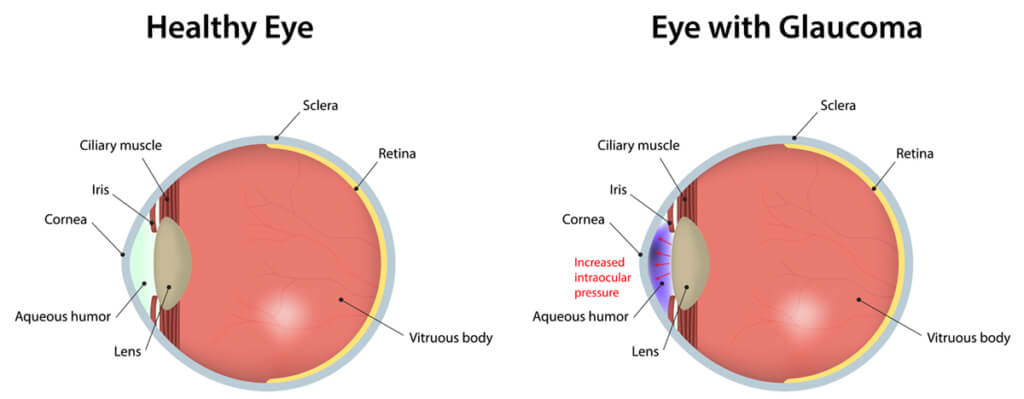Glaucoma
Glaucoma is an eye condition that damages the optic nerve. This is typically caused by fluid buildup in the eye that leads to high pressure. There are several different types of glaucoma, some of which can cause a very slow loss of vision, and other types can cause changes in vision very quickly.
Typically, the peripheral vision is affected first in glaucoma, which is why it has often been called the silent thief of eyesight. Most patients don’t realize they have the eye condition until they have already experienced irreversible vision loss. Many patients also don’t realize they’ve lost any peripheral vision until much later.

Click Image To Enlarge
There may be no warning signs in the early to mid stages of glaucoma, and that is why it is very important to have routine eye exams to monitor your eye pressure and to look for other signs of glaucoma in the eye. There are many treatment options for patients who are diagnosed with glaucoma.
These may include eye drops, oral medications, lasers, or surgery. Glaucoma vision loss is permanent but can be prevented if diagnosed early and treated.
Monitoring For Glaucoma
Most patients will have several baseline tests done to monitor for glaucoma and determine if a patient has glaucoma. These tests include a complete ophthalmologic exam and history, visual field testing, gonioscopy, pachymetry, and OCT images of the optic nerve.
Visual field testing is a way to formally test an individual’s peripheral vision, which is often affected first in glaucoma. Gonioscopy is the use of a special lens to examine the drainage system of the eye to make sure that there is not a blockage that is causing the eye pressure to be elevated.
Pachymetry is a measurement of the thickness of one’s cornea, as individuals with thinner corneas are at a higher risk for glaucoma. OCT (optical coherence tomography) is a sophisticated imaging machine that captures high-resolution maps and images of the optic nerve to measure its thickness and compare it to the normal thickness of an individual.
Treating Glaucoma

Eye Drops
For patients who are at risk for glaucoma or who have the early stages of glaucoma, eye drops are often initiated to lower the pressure inside the eye. Lowering eye pressure has been shown to significantly slow or stop the progression of glaucoma.
There are many different options for glaucoma drops that require a discussion between you and your eye doctor. Each glaucoma drop has some advantages and disadvantages, depending on the individual patient and insurance coverage.
Some patients require 2 or 3 different glaucoma drops to keep the eye pressure down. The target eye pressure also can vary from individual to individual, depending on the baseline eye pressure and other variables.
Selective Laser Trabeculoplasty (SLT)
Selective Laser Trabeculoplasty (SLT) is a very safe laser option to lower eye pressure and is an alternative for some patients who cannot tolerate eye drops, have difficulty remembering to take eye drops, or have other reasons for not wanting to take eye drops. It can also be used in some patients already on one glaucoma drop as a way to lower eye pressure further instead of adding an additional eye drop.
SLT lowers eye pressure in the majority of patients but does not work for everyone. For those individuals where it does not work initially, a second treatment can often be effective. Talk to your eye doctor further to see if SLT is an option for you.
Glaucoma Surgery
MIGS (Minimally Invasive Glaucoma Surgery)
For patients with mild to moderate glaucoma who are undergoing cataract surgery, MIGS is now an option to help lower eye pressure at the time of cataract surgery. There are now several MIGS devices that are approved for patients with mild to moderate glaucoma that can be implanted at the time of cataract surgery in the hopes of lowering eye pressure so that many patients will no longer require glaucoma drops after surgery.
Talk to your eye surgeon to see if MIGS is an option for you. At Eye Consultants of North Dakota, we offer our glaucoma patients the following MIGS options:
Micropulse Cyclophotocoagulation (CPC)
Micropulse cyclophotocoagulation (CPC) is a MIGS procedure that uses a laser to reduce intraocular pressure in glaucoma patients. With micropulse CPC, treatment is not invasive, using short bursts of thermal energy to avoid burning and overheating tissues in the ciliary body.
Shrinking the ciliary body allows the drainage system to open up enough to reduce pressure in the eye. Like other MIGS procedures, micropulse CPC can be performed during cataract surgery, making it a more convenient option for glaucoma patients with cataracts.
iStent inject W
iStent inject W is for patients with mild to moderate open-angle glaucoma. Like many other MIGS procedures, the iStent inject W is meant for patients with glaucoma having cataract surgery.
The iStent inject W is one of the smallest devices you can have implanted in the body. The iStent creates two bypass paths using two micro-bypass stents that go through the trabecular meshwork.
Creating these pathways helps increase liquid output in the eye through Schlemm’s canal. The stents increase access to collector channels while improving how fluid drains from your eye.
The iStent inject W is micro-invasive, supporting the best outcomes for patients after cataract surgery. It leaves tissues and anatomy in the eye intact, meaning that patients can have other procedures in the future or have drug delivery devices implanted if necessary.
Choosing to have the iStent inject W implanted helps to reduce intraocular pressure and may help eliminate the need for glaucoma medications. Treating glaucoma during cataract surgery means you’ll only need one procedure instead of a separate one to treat glaucoma.
The iStent inject W can reduce your intraocular pressure, stopping further glaucoma progression while improving your ability to drain fluid from your eye.
iStent infinite
The iStent infinite Trabecular Micro-Bypass System Model iS3 is an implantable device. It’s used to reduce intraocular pressure in patients with primary open-angle glaucoma who have not been successful with previous medical and surgical treatments.
The iStent infinite uses three anatomically designed stents preloaded into an injector system. It is a first-of-its-kind, standalone implantable alternative that provides robust technology to deliver constant, 24/7 long-term control of intraocular pressure in glaucoma patients who have failed when trying previous surgical procedures and medical intervention.
The iStent infinite is a micro-invasive alternative for patients needing to rely on medications like daily eye drops to control their intraocular pressure. Choosing the iStent infinite can help reduce rates of patient non-compliance and keep glaucoma from progressing, allowing patients to support the vision they have.
The iStent infinite creates arcs of flow while minimizing disruption to tissues in the eye, resulting in a broader range of coverage compared to other MIGS procedures. iStent infinite is also versatile, making it an excellent choice for many glaucoma patients.
Part of its versatility comes from the fact that it can be combined with cataract surgery or performed in a standalone surgical setting. iStent infinite maximizes outflow while minimizing disruption to the eye’s natural anatomy.
It does this because it only occupies 3% of Schlemm’s canal, leaving the other 97% untouched. Combining this with the iStent infinite’s patented multidirectional stent design allows it to bypass resistance and restore physical outflow in the eye.
Tube / Shunt / Trabeculectomy
For patients with moderate to severe glaucoma, glaucoma surgery may be necessary. Most patients who require surgery have eye pressure that is too high despite attempts to lower the pressure with multiple eye drops or lasers.
Some patients may be offered a glaucoma tube or a glaucoma shunt, which are drainage devices that are implanted to lower eye pressure more substantially than most glaucoma drops or SLT lasers. A trabeculectomy (trab) is a type of glaucoma surgery that also lowers eye pressure without implanting a shunt.
At Eye Consultants of North Dakota, Dr. Grosz performs trabeculectomies. Some patients may need to be referred to a glaucoma specialist, and this would be coordinated through Eye Consultants of North Dakota when indicated.


